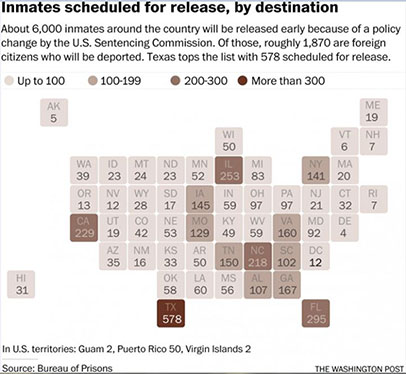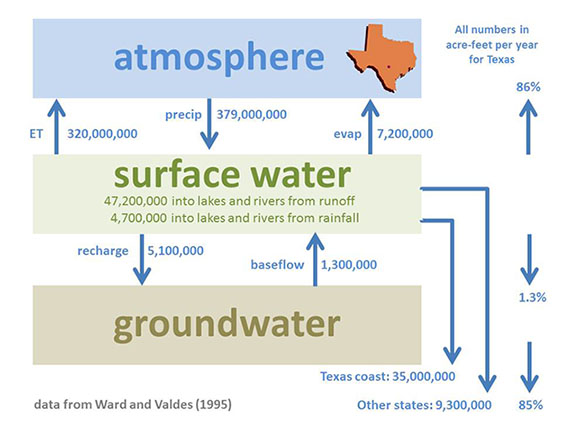- Amendment language
- What did this amendment do?
- FAQs and training materials
- Materials from public meetings and hearings
- Public comment
- Federal Register notices, court-related materials, speeches, remarks, and press releases.
Week in Review, October 15th
Oct 15
- Read about the retroactive sentence reductions under the 2014 Drug Guidelines Amendment. (United States Sentencing Commission, accessed October 14, 2015)
- Track multi-state arrests of prisoners released in 2005. (Bureau of Justice Statistics, September 2015)
- Explore the consequences of frequent text messaging by adolescents. (Psychology of Popular Media Culture, October 5, 2015)
- Learn about the 158 families contributing millions to Democratic and Republican presidential candidates. (New York Times, October 10, 2015)
Texas Water!
Oct 13

- 86 percent of all rainfall in Texas is evaporated or evapotranspirated ("plant sweat") back into the atmosphere.
- Only 1.3 percent of all the rainfall and surface water runoff actually make it down into the aquifer system.
- 40 percent of all water used in Texas, whether surface water or groundwater, comes from the Ogallala Aquifer in the Panhandle.
- Direct potable reuse: In a first for the United States (and only the second place in the world), Texas has started directly reusing treated wastewater for drinking water. The Colorado River Municipal Water District in Big Spring and the city of Wichita Falls are early adopters.
- Aquifer Storage and Recovery (ASR): This process injects water back into an aquifer for later use. ASR avoids the ravages of evaporation, and has been utilized in San Antonio with transfers from the Edwards Aquifer to the Carrizo Aquifer.
- Desalination: Texas already has over 200 groundwater or surface water desalination plants inland, the largest being in El Paso. The 2012 State Water Plan includes proposals for five seawater coastal desalination plants.
- Water conservation: The average person uses 100 gallons of water per person per day, but conservation can dramatically reduce this amount. Dr. Mace suggested that by carefully studying our own water budgets, we can help save water for future Texans.
Cover image from Pixabay user ronymichaud
- Review the draft damage assessment and restoration plan and the draft environmental impact statement about the Deepwater Horizon oil spill. (National Oceanic and Atmospheric Administration, October 2015)
- Consider the circumstances of youths aged 16 to 24 who are not working or in school. (Congressional Research Service, October 1, 2015)
- Explore how the health of pets and people is intertwined. (Centers for Disease Control and Prevention, October 6, 2015)
- Examine statistics related to victims of identity theft. (Bureau of Justice Statistics, September 2015)
- Read about the top ten most dangerous cities in America. (24/7 Wall St., September 30, 2015)
- Take a look at Texas-themed Instagram accounts. (Wide Open Country, October 7, 2015)
- Read about new design standards for federal government websites. (Huffington Post, September 28, 2015)
- Review maps, charts, and data related to the foreign-born population in the U.S. (Pew Research Center, September 28, 2015)
- Track job creation from startups. (U.S. Census Bureau, September 28, 2015)
- Examine the present and future of urban mobility. (McKinsey Insights, September 2015)
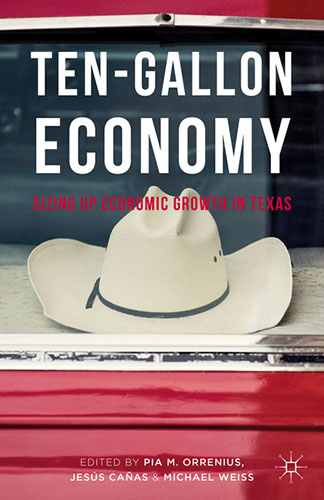
1. Ten-gallon Economy: Sizing Up Economic Growth in Texas By Pia M. Orrenius et al., editors
Presents an in-depth examination of the Texas economy in celebration and recognition of the Federal Reserve Bank of Dallas centennial. Explores the reasons for Texas' recent economic growth and whether this growth comes with costs to be paid in the future. Includes discussions of the margin tax, education challenges, human capital investment, labor market polarization, the shale oil boom, banking trends, energy prices, manufacturing, and economic issues at the Texas-Mexico border. Notes the key to Texas' recent economic success is its ability and willingness to change.
Palgrave Macmillan, 2015. 248 pages.
330.9764 OR7T 2015
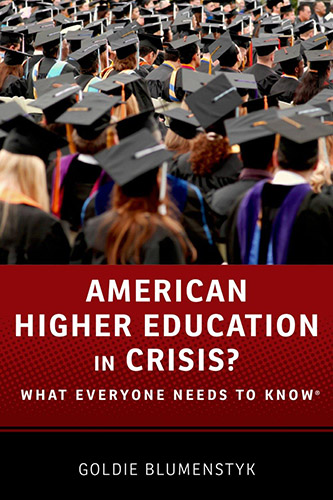
2. American Higher Education in Crisis? What Everyone Needs to Know By Goldie Blumenstyk
Examines the current state of higher education in the United States and what colleges & universities are doing to adapt to the changing post-secondary education environment. Profiles the new "normal" student, identifying who they are and what they hope to get from a college education. Explores the challenges of higher education financing, from ballooning student loan debt to ever-tightening institutional budgets. Considers the internal and external leadership struggles many universities face, including changing ideas around campus governance structures and new federal accountability measures. Concludes with a consideration of several potential "disruptors" of higher education, such as big data, MOOC's, apprenticeships, and alternate methods of credentialing.
Oxford University Press, 2015. 214 pages.
378.73 B627A 2015

3. The Public Wealth of Nations: How Management of Public Assets Can Boost or Bust Economic Growth By Dag Detter and Stefan Fölster
Argues that the main focus of a nation should be how effectively an asset is being managed – not on whether the asset is privatized or public. Examines the position that politicians may not make good managers by the very nature of politics and differing financial philosophies. Suggests state-owned commercial assets would be better off transferred to a national "wealth fund" that would be run by the most talented private and public sector managers to create "public wealth."
Palgrave Macmillan, 2015. 230 pages.
336 D484P 2015

4. Conservative Heroes: Fourteen Leaders Who Shaped America, From Jefferson To Reagan By Garland S. Tucker III
Explores the development of conservatism in America and its fundamental principles, from the founding of the Republic to modern day, by examining the lives and ideas of fourteen leaders who championed the tenets of conservatism. Highlights five fundamental principles of American conservatism and demonstrates how these leaders put these principles into action. Profiles founders of the American Republic, congressional leaders, presidents, the man who revived the Republican party, and the three men behind the rise of modern conservatism.
Intercollegiate Studies Institute, 2015. 234 pages.
320.52 T796C 2015
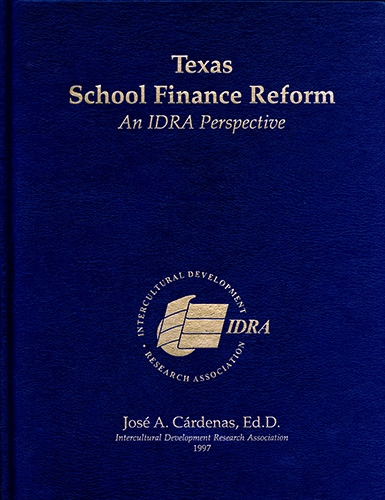
5. Texas School Finance Reform: An IDRA Perspective By Dr. José A. Cárdenas
Chronicles the first 25 years of the fight for school finance reform from the perspective of a key player, Jose Cardenas, the superintendent of the Edgewood School District at the time of the first lawsuit. Recounts the very complex story of the litigation as just that, a story, in a clear and very readable manner. Discusses the issue of school finance reform from a long historical perspective, arguing that schools have always been inequitably funded in Texas. Examines each piece of the puzzle, first in a clear chronological order by years, and then by the legislation that resulted from the opinions of the courts. Considers the beginning of the grassroots fight that continues to this day, giving the reader a good understanding of what transpired to get us to the current point in this story.
Intercultural Development Research Association, 1997. 387 pages.
379.12 C178T 1997
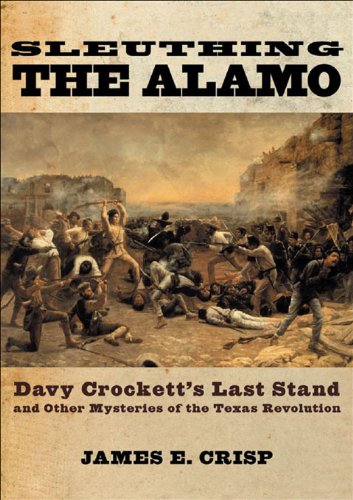
6. Sleuthing the Alamo: Davy Crockett's Last Stand and Other Mysteries of the Texas Revolution By James E. Crisp
Presents a thoughtful reassessment of Texas Revolution topics separating Texas history from myth. Examines a Sam Houston speech, de le Peña's diary, Davy Crockett's death, and paintings showing the fall of the Alamo to demonstrate a true history detective's search for the truth behind long-held beliefs. Engages the reader in a research process that has application beyond historical matters, showing the value of going back to basics and being doubtful of accepted sources and previous scholarship.
Oxford University Press, 2005. 212 pages.
976.403 C868S 2005
- Browse a list of the upcoming bond elections throughout Texas. (Texas Comptroller of Public Accounts, September 23, 2015)
- Read about sexual assault and misconduct on college campuses nationwide. (Westat / Association of American Universities, September 21, 2015)
- Review survey results about employer-sponsored health coverage. (Kaiser Family Foundation, September 22, 2015)
- Consider whether fidgeting might be beneficial for desk-bound workers. (Forbes, September 23, 2015)
- Examine suspensions and expulsions of Black students in Southern states. (Center for the Study of Race & Equity in Education, ©2015)
- Review changes to the Texas assessment program for the 2015–2016 school year. (Texas Education Agency, September 4, 2015)
- Read about the wearing out of voting machines. (Brennan Center for Justice, September 15, 2015)
- Consider the implementation of rules aimed at modernizing the food safety system. (U.S. Food and Drug Administration, September 10, 2015)
- Explore commercial uses of unmanned aircraft systems. (Congressional Research Service, September 9, 2015)
- Consider the health and well-being of women by state. (Institute for Women's Policy Research, 2015)
- Explore American views on mobile etiquette. (Pew Research Center, August 26, 2015)
- Track active wildfires throughout the country. (National Interagency Fire Center, updated Monday through Friday)
- Find a Little Free Library near you. (Little Free Library, ©2009-2015)

